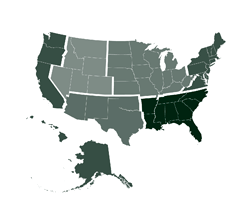September 2009
In this Issue
Flexibility in Combating Homelessness
Development Regulations: How Do They Affect the Local Labor Supply?
Mortgage Insurance Facilitates Affordable Financing
HUD Field Economists Keep Tabs on U.S. Housing Markets
In the next issue of ResearchWorks
HUD Field Economists Keep Tabs on U.S. Housing Markets
Each quarter, HUD's field office economists contribute to U.S. Housing Market Conditions, published by HUD's Office of Policy Development and Research. Located in 13 HUD offices around the country, our economists analyze economic changes and their impacts on local and regional housing markets. They gather information from state and local governments, housing industry sources, and HUD’s ongoing research to provide 10 regional reports and selected profiles of metropolitan areas to produce a quarterly synopsis of market trends and conditions.
The regional and metropolitan narratives include current economic developments and trends in employment, housing sales and prices, apartment vacancy rates and rents, and residential building activity. The following summary findings and analysis drawn from the first quarter 2009 U.S. Housing Market Conditions' "Regional Activity" section are for the New England, New York/New Jersey, Mid-Atlantic, Southeast/Caribbean, Midwest, Southwest, Great Plains, Rocky Mountain, Pacific, and Northwest regions of the country.

Regional Activity
Employment Trends
- Of the 10 regions in the report, only the Southwest gained jobs, while 8 registered employment declines and 1 region remained unchanged.
- The largest employment losses in most regions were seen in the construction and manufacturing sectors.
- Education, health services, and government were the most frequently reported growth sectors. Only the New York region reported a notable increase in leisure and hospitality employment.
Sales Market Trends
- State-level home sales increased significantly in California and Florida, largely due to the respective 40 and 30 percent declines in median sales prices; sales decreased in the remaining 29 states discussed in the report.
- Northern Virginia, Las Vegas, Phoenix, Minneapolis, and Brunswick, North Carolina were the only metropolitan areas and state regions (of the 75 cited) where existing home sales increased.
- State-level home sales prices increased in North Dakota, South Dakota, Wyoming, and Montana, or just 4 out of the 29 states analyzed.
- Metropolitan area home sales prices increased in less than 10 percent of the 85 markets cited, including San Antonio, Beaumont, and Bryan-College Station, Texas; Tulsa, Oklahoma; Wichita, Kansas; and 3 smaller markets in North Carolina.
Rental Market Trends
- Apartment vacancy rates increased in more than three-fourths of the 81 metropolitan area rental markets cited, mainly due to weaker economic conditions and new apartments, single-family homes, and condominiums entering the rental market.
- Vacancy rates declined in just four of the rental markets discussed — Tulsa, Philadelphia, Baltimore, and Palm Beach.
- Average apartment rents increased moderately or were unchanged in nearly every market covered, with the exception of declines in six areas — New York City, Long Island, Boise, Fort Lauderdale, Miami, and Palm Beach.
Residential Building Trends
- Single-family building activity declined in all 50 states reported on, because of slow home sales market conditions.
- Multifamily building activity declined in all but nine states — Arkansas, Massachusetts, Rhode Island, New Hampshire, Utah, South Dakota, Wyoming, Hawaii, and Kentucky.
Metropolitan Activity
This issue of U.S. Housing Market Conditions features metropolitan profiles for Atlanta-Sandy Springs-Marietta, Georgia; Denver-Aurora-Boulder, Colorado; Midland-Odessa, Texas; Nashville-Davidson-Murfreesboro-Franklin, Tennessee; Phoenix, Arizona; Rochester, New York; Sacramento–Arden-Arcade–Roseville, California; and Tulsa, Oklahoma. Details from the latest Housing Market Profiles, available in greater detail in the “Regional Activity” portion of the report, include the following:
- In the Denver-Aurora-Boulder, Colorado metropolitan area, ConocoPhillips Company is constructing a $1 billion renewable energy research training center that is projected to employ more than 7,000 people when completed in 2030.
- In the Nashville-Davidson-Murfreesboro-Franklin, Tennessee metropolitan area, the apartment vacancy rate increased from 5.8 to 9.4 percent; soft market conditions are expected to continue, as 2,100 rental units are currently under construction.
- In the Atlanta-Sandy Springs-Marietta, Georgia metropolitan area, the condominium sales market was soft with more than 6,000 unsold units and 1,400 units under construction.
- Rental market conditions were tight in the Midland-Odessa, Texas metropolitan area, due to strong population growth and relatively few new apartments entering the market.
These quarterly regional reports and metropolitan area profiles are just two features of the U.S. Housing Market Conditions reports. Each issue also contains national data on housing sales, prices, and affordability; building permits, housing starts, completions and apartment absorptions; foreclosure rates; vacancy rates; and homeownership rates, among other key variables. Every report highlights an article of interest, such as a recent piece, "New Low-Income Housing Tax Credit Project Data Available." Current and back issues of the report are available as free downloads at www.huduser.gov/periodicals/ushmc.html, and print copies can be ordered at no cost by calling HUD USER at 800.245.2691, option 1.

